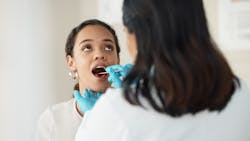Oral lichen planus and the periodontal appointment
Oral lichen planus (OLP) is a common periodontal referral from general dentists. According to John Hopkins Medicine, approximately one in every 100 people in the United States is affected by lichen planus, and OLP accounts for approximately 2% of all cases.1,2
Common types of OLP
The etiology of oral lichen planus is unknown, but it is believed to be associated with autoimmune diseases and is frequently seen in more women than men. OLP is a chronic condition that can range from mild to severe and clinically presents in a variety of patterns. The two most common types of OLP are:
Reticular OLP: this presents as lace-like pattern typically found on the buccal mucosa, the most common type of OLP.
Erosive/ulcerative OLP: this presents as bright red patches due to the loss of the top layer to mucosa and can be painful. This is the second most common type of OLP, and it can migrate throughout the patient's mouth.3
What to expect during the periodontal appointment
During the initial evaluation, the periodontist will discuss whether they recommend a biopsy to confirm the diagnosis of OLP and to rule out malignancy. The biopsy is often performed by an oral surgeon, and the results are reviewed by an oral pathologist. The Academy of Oral Medicine reports that while the probability of OLP becoming cancerous is controversial, there are cases where malignancy has been reported.2
You might also be interested in:
On the tip of my tongue: Differential diagnoses for tongue lesions
Dental providers may take impressions of the patient’s mouth to make custom trays to be used to hold a prescription topical corticosteroid prescribed by the periodontist. Dentists often recommend that the topical steroid be used up to three times per day.3 Additional non-pharmaceuticals such as StellaLife Vega Oral Care products can be purchased over the counter and easily placed in the custom-made trays. The use of topicals has shown to boost healing and improve patients’ quality of life.
Intraoral photos should be taken of all affected areas with OLP. This allows dental providers to accurately evaluate any changes in the oral cavity, the severity of the OLP, and the location of the lesions. Intraoral photos should be updated to document changes in the lesions. There are studies that suggest that the risk of developing squamous cell carcinoma is 10 times higher in patients with OLP than those without.3 Intraoral photos and accurate documentation will help in tracking subtle changes in the OLP lesions.
Oral hygiene recommendations and OLP
It's vital to educate the patient on OLP, its impact on the oral cavity, and the influence on daily life. Oral lichen planus can affect a patient’s diet; acidic, spicy, and salty foods are often painful to eat. Suggest keeping a food diary to help pinpoint specific foods that irritate or cause OLP to be more painful; avoiding these foods may help manage symptoms.
When a patient is referred for a periodontal evaluation in conjunction with a potential periodontal disease diagnosis, remember that they’re usually experiencing oral discomfort. Often the diagnosis and treatment need to be performed separately. Poor oral hygiene will contribute to worsening OLP symptoms.
As well, which type of OLP the patient is experiencing can affect their home care. Patients have reported that toothpaste flavorings can make OLP symptoms worse, so you might recommend mild toothpastes with little to no flavoring for these patients.2 Dental professionals should thoroughly explain how plaque control and OLP are connected, and the importance oral hygiene plays in disrupting the flareup cycle.
Long-term treatment goals for OLP patients
The long-term treatment goals for patients with OLP are to have routine cleanings every three months, alternating between the general dentist and a periodontal practice. Routine periodontal measurements should be documented to closely monitor periodontal disease, including recession, mobility, and furcation involvement. Intraoral photos should be reviewed at each visit and compared to the current OLP presentation.
Education is a key to success when discussing long-term goals with patients; preparing them for the future will help them manage chronic conditions like OLP.
References
- John Hopkins Medicine. Lichen planus. Accessed March 3, 2023. https://www.hopkinsmedicine.org/health/conditions-and-diseases/lichen-planus
- Burkhart N. Oral lichen planus. American Academy of Oral Medicine. Accessed March 3, 2023. https://www.aaom.com/oral-lichen-planus
- Edwards PC, Kelsch R. Oral lichen planus: clinical presentation and management. Accessed March 3, 2023. J Can Dent Assoc. 2002 Sep;68(8):494-499. PMID: 12323106.
About the Author
Melissa Van Witzenburg, MS, RDH
Melissa has been practicing dental hygiene for 23 years. She continues to pursue her passion by educating the aging population about oral health and systemic links. Melissa also works clinically in a periodontal office in the Chicagoland area. For more information, email her at [email protected].

